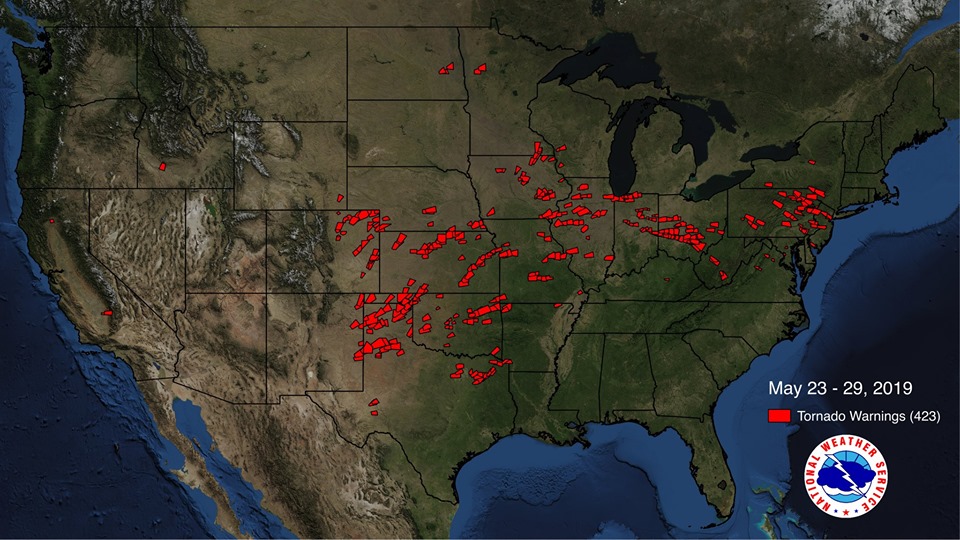Tornado season has started and Colorado is already feeling it big time.
We've had a few weather-related curveballs in Colorado the last few months, and this last week, they came in the form of tornadoes. Between Sunday, May 26, and Monday, May 27 (Memorial Day), there were close to 20 tornadoes confirmed in the state of Colorado! Spring hailstorms brought golf ball-sized hail, with 60 mph wind gusts added to the mix, making for a very rough few days. This outbreak of severe weather caused flights to be temporarily stopped out of Denver International Airport on both days, as conditions were unsafe for flying.
10 of the tornadoes were spotted Sunday in Eastern Colorado, most were small and touched down on the ground for only a few minutes; there was no damage reported. On Memorial Day, there were at least eight observed tornadoes reported in Colorado and a whopping 72 confirmed across the United States that day alone, according to the National Oceanic and Atmospheric Administration (NOAA).
Colorado ranks as the 10th most active state for tornadoes in the country and sees an average of 52 tornadoes each year. Weld Country holds the state record, having had 269 confirmed tornadoes since 1950. This year’s first tornado was spotted in Weld County on March 22.
Though we do not see as many tornadoes as states such as Texas and Oklahoma, Colorado has seen its share of tornado damage and destruction with over 2,100 tornadoes in the state since the 1950s. The eastern plains of Colorado are part of the western edge of Tornado Alley, a group of 19 states that are prone to a high number of destructive tornadoes. Conditions in Tornado Alley are ripe for tornadoes to form, and very hot temperatures combined with powerful spring and summer thunderstorms create the perfect combination for tornadoes to occur. Many people outside of the state do not realize that Colorado is a part of Tornado Alley, however, warnings and watches are a pretty common occurrence and something residents are used to.

Image Courtesy of Pexels.
This year’s tornado season is already quite active, in fact, it's the most active prolonged period of tornadoes activity in eight years – it's the first 30-day period with more than 500 reports of tornadoes since April 2011. Weather conditions play a huge role in this; a stagnant jet stream pattern has caused this severe weather outbreak with tornadoes, hail, torrential rains, lightning, and flooding in multiple states.

Courtesy of U.S. National Weather Service (Facebook).
Colorado has been lucky so far this year with no major damage, injuries, or death from the tornadoes. Staying safe is a top priority and being educated and prepared is the best first step. NOAA offers some tips and guidelines to keep safe in a tornado.
The very first step is to know the signs of a tornado, especially if you live somewhere they have occurred. Keep your eyes and ears open for these signs, courtesy of the NOAA's safety guide:
- Strong, persistent rotation in the cloud base.
- Whirling dust or debris on the ground under a cloud base – tornadoes sometimes have no funnel!
- Hail or heavy rain followed by either dead calm or a fast, intense wind shift. Many tornadoes are wrapped in heavy precipitation and can't be seen.
- Day or night – Loud, continuous roar or rumble, which doesn't fade in a few seconds like thunder.
- Night – Small, bright, blue-green to white flashes at ground level near a thunderstorm (as opposed to silvery lightning up in the clouds). These mean power lines are being snapped by very strong wind, maybe a tornado.
- Night – Persistent lowering from the cloud base, illuminated or silhouetted by lightning, especially if it is on the ground or there is a blue-green-white power flash underneath.
If you find yourself in a tornado situation, you must act quickly to keep yourself and those with you safe. Number one is to avoid windows; if you live in a house with a basement get down there and get covered by a blanket, mattress, a tarp, etc., to keep yourself protected. If you don't have a basement, get on the lowest floor possible, avoid windows and get covered, take cover in a hallway, bathroom or closet for example. If you are in a mobile home and a tornado hits, you are likely in grave danger, and if possible, should get out before it hits. If you are caught out in the open, take action by lying flat on the ground, face down with your arms covering your head, staying as far away from cars, trees, benches, and/or anything that may be blown around during the twister.
Developing and teaching your family a tornado safety plan is a great idea before a tornado situation happens. Going over what to do before and after, as well as where to go, are just some ways to better prepare yourself and come out of what can be a very harrowing situation in one piece.
What do our readers think, are tornadoes a big concern to Coloradans? Do you have any pictures of the recent tornadoes to share with us? Have you been caught in a tornado and have advice or insights to share with us? Please let us know in the comments below.
